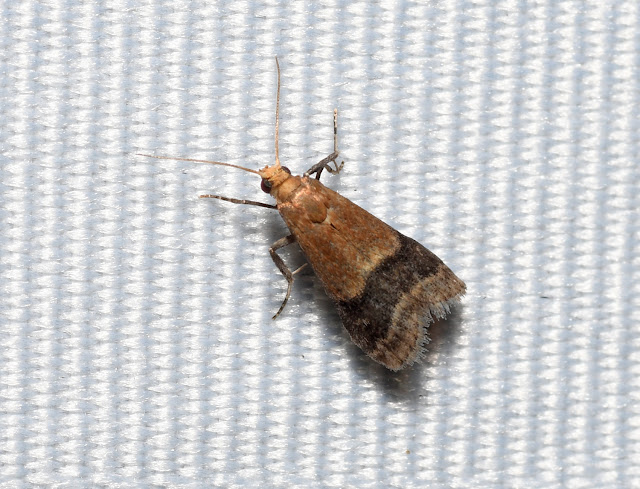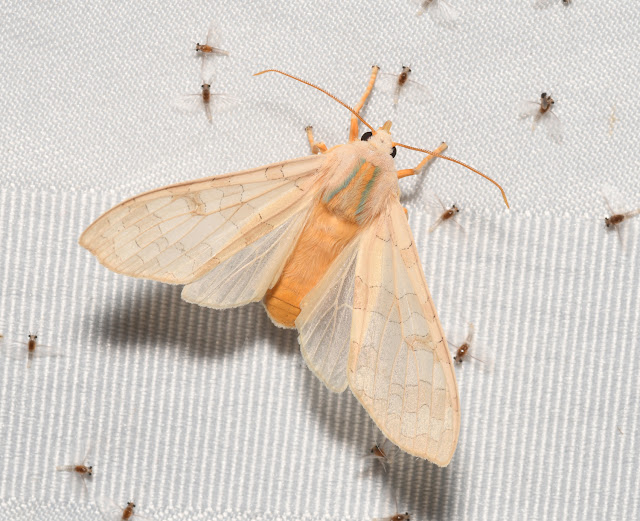Sugaring is the application of a sugary mixture onto the trunk of various tree within an area, to attract species that are attracted to this sugary mixture - especially underwing moths (Catocala). The exact recipe for the mixure can vary, but I used three old bananas, half a cup of sugar, half a beer and a dash of Forty Creek whisky for good luck. I let the concoction sit and ferment for a couple of days and then took it out into the forest to paint onto the sides of trees. In addition to underwing moths, this is a great way to see a variety of different invertebrates including harvestmen, ants, cochroaches, spiders, etc (everyone's favourites!).
 |
| Eastern Carpenter Ants - Short Hills Provincial Park, Niagara Region, Ontario |
During my first foray to Short Hills I was joined by Laura as well as our friends Todd and Kathryn. I wasn't sure how successful this would be since it was my first time attempting this, but we had moderate success. We set up the moth sheet in a riparian area that was dominated by Black Walnut with smaller numbers of Basswood, White Ash, Sugar Maple and occasional Shagbark Hickory and other species. We decided to bait several of the trees within 100 m of us to make it easy to check them frequently.
 |
| Yellow-banded Underwing - Short Hills Provincial Park, Niagara Region, Ontario |
The above underwing is known as the Yellow-banded Underwing and it was the main species that we observed taking the bait. Underwing moths are pretty impressive to see in real life (as opposed to in the pages of a field guide). While it can be hard to appreciate the beautiful colours and patterns when reading the field guide, in real life these moths are quite attractive. Some of the species are rather large in size, as well. This Yellow-banded Underwing took an affinity to Laura's hair. In this image you can see why they are called underwings. While the forewings are coloured with browns and grays to blend in, the usually hidden hindwings exhibit various colours and patterns. Most species have hindwings banded with yellow/orange/red and black, though some species have black hindwings.
 |
| Yellow-banded Underwing - Short Hills Provincial Park, Niagara Region, Ontario |
Near the end of the night I spotted a different species of underwing which I later identified as Penitent Underwing. Unfortunately after I took a single image the moth flew away, never to be seen again. In the field guide many of these moths look impossibly similar, but the identification is much more straightforward "in the field". That being said, some of the species are still rather tricky.
 |
| Penitent Underwing - Short Hills Provincial Park, Niagara Region, Ontario |
The next species is not a true underwing in the genus Catocala, though its common name is American Copper Underwing. It too was seen taking the bait.
 |
| American Copper Underwing - Short Hills Provincial Park, Niagara Region, Ontario |
 |
| American Copper Underwing - Short Hills Provincial Park, Niagara Region, Ontario |
On Friday evening I returned to Short Hills on my own. I decided that I would set up my sheet in an area that contained more upland habitat and I searched out a part of the forest where oaks and hickories were more numerous. Different underwing moths have different host plants; that is, trees and shrub species on which the caterpillars feed. Oaks, Hickories, Black Walnut, Butternut, Honey Locust, Black Willow, Apple and Hawthorn are some of the common food plants for Ontario's underwing moth species. I was hoping that by picking a different area, I would see some different species of underwing moth. I also made an effort to bait more trees this time - about fifteen or so.
My hunch was correct and the mothing was excellent! I probably saw 20-25 individual underwing moths and it was common to see 2-3 individuals on many of the baited trees.
I I had to pick a favourite species, the Clouded Underwing would have to be it. It was a species I had never seen before and at least three different individuals were detected. The colours on a fresh Clouded Underwing are just incredible.
 |
| Clouded Underwing - Short Hills Provincial Park, Niagara Region, Ontario |
Clouded Underwing is a more southern species and is uncommonly reported in Ontario.
 |
| Clouded Underwing - Short Hills Provincial Park, Niagara Region, Ontario |
By far the most common underwing species of the evening was Bride Underwing with perhaps fifteen individuals observed. Its main food plants include Black Walnut and Butternut. While I had picked an area of the forest that had fewer walnuts and more maples, oaks and hickories, evidently the walnut-eaters were still present in good numbers.
 |
| Bride Underwing - Short Hills Provincial Park, Niagara Region, Ontario |
 |
| Bride Underwing - Short Hills Provincial Park, Niagara Region, Ontario |
 |
| Bride Underwing - Short Hills Provincial Park, Niagara Region, Ontario |
 |
| Bride Underwing - Short Hills Provincial Park, Niagara Region, Ontario |
Sometimes an underwing moth is a little skittish and flushes from the tree trunk. They usually don't go very far - this Bride Underwing landed on a nearby maple sapling and posed nicely.
 |
| Bride Underwing - Short Hills Provincial Park, Niagara Region, Ontario |
While inspecting a baited tree trunk I noticed this strange creature, a type of Jumping Bristletail (family: Machilidae).
 |
| Jumping Bristletail sp. - Short Hills Provincial Park, Niagara Region, Ontario |
A couple of these camel crickets in the genus Ceuthophilus were also making use of the sugary food source.
 |
| Camel cricket (Ceuthophilus sp.) - Short Hills Provincial Park, Niagara Region, Ontario |
Back to the underwing moths! This next one is called an Obscure Underwing, one of the black-winged species. It was very skittish, flying away after a single burst of flash. Fortunately it was back on the tree half an hour later, allowing me to study it at length.
 |
| Obscure Underwing - Short Hills Provincial Park, Niagara Region, Ontario |
While not as flashy as some of the other Catocala species, I really like the look of the black hindwing on Obscure Underwing. Unfortunately I could not get a great photo of that feature.
 |
| Obscure Underwing - Short Hills Provincial Park, Niagara Region, Ontario |
A second species of black-winged Catocala appeared a little later in the evening. This one, known as the Yellow-Gray Underwing, is a bit flashier than the Obscure Underwing pictured above.
 |
| Yellow-gray Underwing - Short Hills Provincial Park, Niagara Region, Ontario |
 |
| Yellow-gray Underwing - Short Hills Provincial Park, Niagara Region, Ontario |
 |
| Yellow-gray Underwing - Short Hills Provincial Park, Niagara Region, Ontario |
The next species, the Darling Underwing, was absolutely stunning with bright pink bands on its hindwing that are just peeking through in the photo below. Darling Underwings feed mainly on willow and poplar species.
 |
| Darling Underwing - Short Hills Provincial Park, Niagara Region, Ontario |
My last check of the trapline produced two new species for the evening, though both I had seen previously. The first is Yellow-banded Underwing, followed by Oldwife Underwing.
 |
| Yellow-banded Underwing - Short Hills Provincial Park, Niagara Region, Ontario |
Underwing Moths sure do have some strange names. My favorites are the "significant other" guild of names, including Girlfriend, Once-married, Betrothed, Bride, Oldwife, Connubial and Sweetheart Underwings. (not to mention the Little Nymph Underwing!). Clearly whoever named these things was a little too into their study subjects.
 |
| Oldwife Underwing - Short Hills Provincial Park, Niagara Region, Ontario |
The following is American Idia Moth. This genus also was frequently noted on the bait, though usually it was the species Glossy Black Idia Moth.
 |
| American Idia Moth - Short Hills Provincial Park, Niagara Region, Ontario |
A Large Yellow Underwing which is an introduced species from Europe (and not a "true" underwing as it is in the genus Noctua).
 |
| Large Yellow Underwing - Short Hills Provincial Park, Niagara Region, Ontario |
I'll finish with one more photo of a Yellow-banded Underwing which was my last Catocala of the evening.
 |
| Yellow-banded Underwing - Short Hills Provincial Park, Niagara Region, Ontario |
It was a pretty productive evening and I was quite pleased with my haul. Below are the species I encountered at Short Hills over the two evenings, along with approximate numbers. I'll definitely be back as the next few weeks progress!
15 Bride Underwing (Catocala neogama)
6 Yellow-banded Underwing (Catocala cerogama)
3 Clouded Underwing (Catocala nebulosa)
2 Yellow-gray Underwing (Catocala retecta)
1 Darling Underwing (Catocala cara)
1 Ultronia Undewing (Catocala ultronia)
1 Oldwife Underwing (Catocala palaeogama)
1 Penitent Underwing (Catocala piatrix)
1 Obscure Underwing (Catocala obscura)















































































